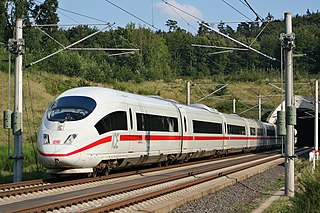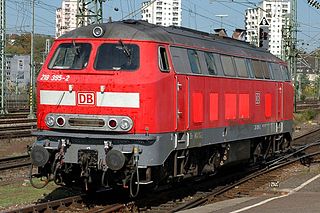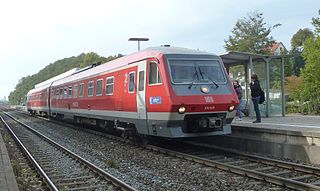
A tilting train is a train that has a mechanism enabling increased speed on regular rail tracks. As a train rounds a curve at speed, objects inside the train experience centrifugal force. This can cause packages to slide about or seated passengers to feel squashed by the outboard armrest, and standing passengers to lose their balance. In such excessive speeds, it could even cause the train to derail. Tilting trains are designed to counteract this by tilting the carriages towards the inside of the curve, thus compensating for the g-force. The train may be constructed such that inertial forces cause the tilting, or it may have a computer-controlled powered mechanism.

The Deutsche Bahn AG is the national railway company of Germany, and a state-owned enterprise under the control of the German government. Headquartered in the Bahntower in Berlin, it is a joint-stock company (AG) and the largest railway company in the world.

Intercity Express is a high-speed rail system in Germany. It also serves destinations in Austria, France, Belgium, Switzerland and the Netherlands as part of cross-border services. It is the flagship of the German state railway, Deutsche Bahn. ICE fares are fixed for station-to-station connections, on the grounds that the trains have a higher level of comfort. Travelling at speeds up to 300 km/h (190 mph) within Germany and 320 km/h (200 mph) when in France, they are aimed at business travellers and long-distance commuters and marketed by Deutsche Bahn as an alternative to flights.

The Talent is a multiple unit railcar manufactured by Bombardier that was developed by Waggonfabrik Talbot in Aachen shortly before the company was acquired by Bombardier in 1995. The name Talent is an acronym in German for TALbot LEichter Nahverkehrs-Triebwagen.

Alstom Traxx is a modular product platform of mainline diesel-electric and electric locomotives. It was produced originally by Bombardier Transportation and later Alstom, and was built in both freight and passenger variants. The first version was a dual-voltage AC locomotive built for German railways from the year 2000. Later types included DC versions, as well as quadruple-voltage machines, able to operate on all four electrification schemes commonly used in Europe. The family was expanded in 2006 to include diesel-powered versions. Elements common to all variants include steel bodyshells, two bogies with two powered axles each, three-phase asynchronous induction motors, cooling exhausts on the roof edges, and wheel disc brakes.

The Double-deck Coach is a bilevel passenger railcar currently manufactured by Alstom, which acquired Bombardier Transportation in 2021 used by various European railways and Israel Railways. The current generation of double-deck coaches can be run at speeds up to 200 km/h (125 mph). Depending on their configuration, each coach can seat 100 to 150 passengers.

The RegioSwinger is a tilting diesel multiple unit (DMU) passenger train used for fast regional traffic on unelectrified lines.

The DBAG Class 612 is a two car, tilting, diesel multiple unit operated by the Deutsche Bahn for fast regional rail services on unelectrified lines.

The DB Class 218 are a class of 4-axle, diesel-hydraulic locomotives acquired by the Deutsche Bundesbahn for use on main and secondary lines for both passenger and freight trains.

DBAG Class 411 and Class 415 are German tilting electric multiple-unit high-speed trains in service with DB Fernverkehr, commonly known as ICE T, operationally referred as ICE-T / LPF-T in the timetable documents.

The DBAG Class 605, commonly known as the ICE TD is a high-speed diesel multiple unit (DMU) train, formerly in service with Deutsche Bahn and DSB. It was retired from active passenger service in 2017 after years of operational issues with one trainset being kept and repurposed as a technology testbed.

The Interregio-Express (IRE) is a local public transport railway service operated by the Deutsche Bahn which is only available in the German states of Baden-Württemberg, Bavaria, Saxony, Saxony-Anhalt and Berlin. The IRE service was first introduced in the 2001 summer timetable, due to the increasing abolition of Interregio routes by DB's long-distance division. As a result, several German states ordered InterRegioExpress trains on the routes affected. In addition IRE trains were also introduced on routes that had not previously had an Interregio service.

The DR 130 family of locomotives comprises the DR Class 130, DR Class 131, DR Class 132 and DR Class 142, in USSR locomotive called TE109 and TE129.

The DB V 160 locomotive family comprises several classes of closely related 4-axle diesel-hydraulic locomotives built in the 1960s and 1970s for the Deutsche Bundesbahn which take the family name from the earliest built model: the 'DB Class V 160'.

The Stuttgart–Horb railway is a 67.227 kilometer-long railway in the southern part of the state of Baden-Württemberg in Germany, running from Stuttgart to Horb. It forms part of a railway known as the Gäubahn or Gäu Railway. The Royal Württemberg State Railways and the Baden State Railways constructed the majority of this line between the years 1866 and 1879. Today the partially single-track, fully electrified line features the high-speed Intercity-Express (ICE) service, with its tilting train technology, traveling from Stuttgart to Zürich. In addition, a multitude of local train services of numerous railway companies are on offer. The Gäu Railway is also a significant line in the North-South freight service system.

The Gemünden–Ebenhausen Railway is a 55 kilometre long, single-tracked, railway line in the northern part of the province of Lower Franconia in Bavaria, Germany. It runs from Gemünden (Main) via Bad Kissingen to Ebenhausen and follows, for most of the way, the Franconian Saale river.

The DB Class 610 is a Diesel Multiple Unit (DMU) train type operated by the Deutsche Bahn in Germany. They were built from 1991 to 1992 by MAN and Duewag. The class uses a tilting Hydraulic Fiat system used in Italian Pendolino trains.

The DR Class V 100, redesignated the Class 110 in 1970, was a four-axled diesel locomotive for medium duties operated by the Deutsche Reichsbahn of East Germany. Locomotives of the type were also supplied to railways in China and Czechoslovakia and to various industrial operators.

The DBAG Class 481/482 is an electric multiple unit train for the Berlin S-Bahn. The class 481 was designed to replace the aging rail cars after the German reunification in 1990. The first mock-up models were presented in 1993 with the first rollout on 22 January 1996.

The train protection system Geschwindigkeitsüberwachung Neigetechnik enables to rise the speed of tilting trains until 30 % above the limits for conventional trains. It is installed on numerous lines in Germany along with the traditional Punktförmige Zugbeeinflussung (PZB) intermittent signalling system.





















